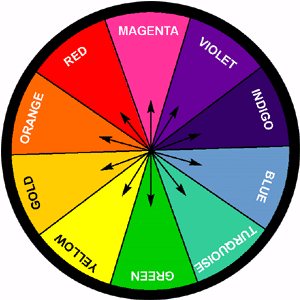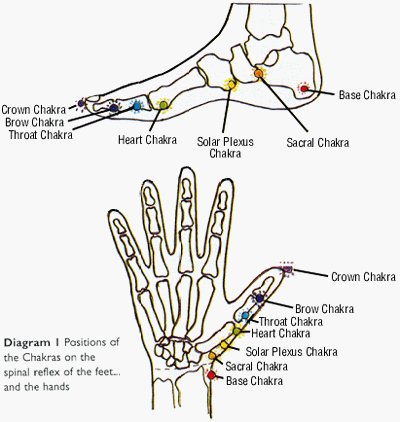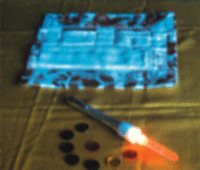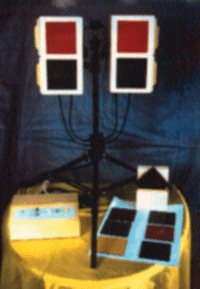Positive Health Online
Your Country

Integrating Colour with Reflexology
listed in reflexology, originally published in issue 17 - January 1997
Reflexology and colour therapy have their roots in the distant past. As individual therapies, they have tremendous therapeutic value. When used in conjunction with each other, they have shown their ability to both complement each other and accentuate the healing process.

Diagram 2 Color wheel depicting color, with its complementary color
The origin of reflexology, or zone therapy as it was called, still remains a mystery. One theory, mentioned by Dr. Fitzgerald, in his book Zone Therapy, is that it originated from China some 5,000 years ago as a form of pressure point treatment. Dr. Fitzgerald was an ear, nose and throat specialist, and must be credited for his part in reviving reflexology. Another conjecture is that it began in Egypt.
Evidence for this stems from an Egyptian tomb drawing dating back to 230BC. This drawing depicts four people. One person is being treated with foot massage and a second person with hand massage. Others credit its birth to the Incas. These were people of very ancient Peruvian civilisation, possibly reaching back to 1200BC. It is speculated that they passed their knowledge of zone therapy down to the North American Indians who, up to this present time, are still using this form of treatment.
It was believed that the method formulated by Dr. Fitzgerald was based on acupuncture. Of the twelve meridians used in acupuncture, six terminate or originate on the feet and six terminate or originate on the hands. If one follows the path of these meridians, from their point of origin or termination over the feet and hands, they form the ten longitudinal zones formulated by Fitzgerald.
It was Eunice Ingham, a student of Fitzgerald's, who instigated what we today know as reflexology. Through her dedicated research, she was able to correlate the anatomical structure of the body to the energy zones found on the feet and on the hands. This made both the feet and the hands a mirror image of the entire body; the microcosm of the macrocosm.
The principal teaching behind reflexology states that the body is divided into ten vertical energy zones, inside which are encompassed the organs, muscles and skeletal structure of the physical body, all of which are reflected on the soles of the feet and palms of the hands. The occurrence of energy blocks in a human person, and the reasons for these are many, are likewise reflected on the hands and the feet in one or more of the zones located there. Through the use of specific pressure techniques, these energy blocks can be detected through the presence of pain or crystalline formation under the skin.
Colour as a therapy also reaches far back into history, but unlike reflexology, it is still in its infancy of rediscovery. It is speculated that colour therapy was used by the Atlanteans. It is believed that they built temples with ceilings that were domed and constructed from interlocking crystals that dissipated light into the colour spectrum. Around the circumference of these temples were healing rooms, each reflecting one of the colours dissipated from these crystals.
Archaeologists have discovered that the Egyptians, like the Atlanteans, also incorporated colour healing rooms into their temples and used these not for physical illness alone, but for childbirth, counselling and to aid the transition of the soul at death.
India used and still uses colour in gem therapy. Indian gem therapists believe that gem stones are the storehouse of cosmic colour and that everything manifest is composed of the seven rays which are primeval, formative forces of nature. There, therapeutic techniques incorporate several methods of releasing this colour force.
At the beginning of the nineteenth century, with the discovery of new drugs and advances in surgical procedure, colour therapy started to be replaced by allopathic medicine. What is interesting is that some of the early pioneers of allopathic medicine, continued to use colour in their treatments. One such pioneer was Paracelsus (1493-1541). Paracelsus developed considerable interest in alchemy, astrology and occult sciences. His love of alchemy and his application of this in his treatments earned him the title 'father of pharmacology'. Another pioneer was Hippocrates (460-370BC), also well versed in alchemy and known as 'father of medicine'. He was famous for his 'Hippocratic Oath'.
With the growing awareness of the detrimental effects of allopathic drugs, the percentage of people returning to complementary therapies has started to increase. Unlike allopathic treatment, complementary therapies aim to deal with the cause and not the manifested symptom. This is frequently an alien concept which some people find difficult to work with. But, unless the cause is found and eradicated, it will continue to manifest as a physical symptom. One way of helping the person to locate the cause is through counselling and colour.
We, as human beings, are beings of light, surrounded and interpenetrated by the colours which constitute visible light. This establishes the electromagnetic field or aura surrounding us. The aura contains six sheaths or layers, all of which interpenetrate with each other and the physical body. It is filled with constantly changing colours, determined by our state of health, physically, emotionally and mentally. How true the sayings: 'green with envy', 'red with rage'.
The layer closest to the physical body is known as the etheric sheath and is the blueprint for the physical body. It contains the very fine energy channels or nadis through which pranic energy flows. This network of infinitely intricate nadis establish the counterpart of the entire nervous system.
As well as containing the nadis, the etheric sheath contains seven major and twenty one minor chakras or energy centres. It also contains numerous acupuncture points. A major chakra is defined by the crossing of 21 nadis; a minor chakra by 14 nadis and an acupuncture point by seven nadis. These force centres can be found in each of the layers constituting the aura, but their primary importance is at the etheric level. They are both the transformers and the transmitters of energy for each of the layers and work with the physical endocrine system. Disease starts in the aura as accumulated energy. If this is not dispersed, it will eventually manifest as a physical disease.
A chakra which is not acknowledged as one of the major centres, but is of prime importance, is the splenic chakra. It is this chakra which absorbs prana, chi or life force and disintegrates it into its seven varieties. Each of these seven varieties of prana vibrates to the frequency of one of the colours on the colour spectrum and establishes the dominant colour of the chakra to which it is distributed.
From these chakras, the colours radiate into the rest of the auric field. Because the feet and the hands present a mirror image of the physical body, they reflect the auric field around themselves. The chakras can also be located along the spinal reflex on both feet and hands. I have found these to be important points for treatment, especially for hormonal imbalances. (Diagram 1)

Diagram 1 Position of the Chakras on the spinal reflex of the feet... and the hands
Although the chakras work mainly with the endocrine glands, they also have an effect on organs, muscles and bones which lie in their pathway. Each colour contains within itself its own spectrum of colour. Therefore the parts of the body related to a specific chakra will vibrate to a frequency contained within the spectrum of colour of that chakra. This I always refer to as the general colour.
When working with the vibrational frequencies of colour in therapy, it has been deemed important to administer the treatment colour followed by its complementary colour. This I have found through experience to be trite. One of my students treated her husband with reflexology and colour for diabetes. Unfortunately, she forgot to administer the complementary colour after the treatment colour. This resulted in his blood sugar, after stabilizing, suddenly rising. By treating with colour complementary colour, we work with polarity. Polarity teaches that complementary energies have to be in balance to create harmony. (Diagram 2)
When combining colour with reflexology, colour is used for three conditions. The first is to work with the cause, the second to help keep the body in balance and the third to work with the manifested disease. Sometimes all three conditions are treated with colour during a therapy session. At other times only one or maybe two of the conditions are worked with.
When treating a person with the combination of these two therapies, a complete reflexology treatment is initially carried out. A reflexology treatment is diagnostic, thereby enabling a practitioner to locate where problems or potential problems lie. Having completed this, the general colours with their complementary colours are applied to the areas where an abnormality has been diagnosed but which has produced no noticeable symptoms in the physical body. The reason for this can be twofold. It could be related to an accumulation of energy in the etheric layer of the aura, or it could indicate that a particular part of the body is under strain through trying to keep the whole in balance. If, through disease, the vibrational frequencies of the etheric body changes, the change will affect the cellular structure of the physical body. This then affects the force field of the related organ or organs. If the force field of one or more organs is altered, then the body will try to bring itself back into homeostasis. This process can put strain on healthy organs within the physical structure which shows itself as pain on the related reflexes on the feet or hands. Administering the general colour, with its complementary colour, to the related reflex, will help to re-balance its altered function.

Diagram 3 Reflexology crystal torch
The treatment colours, with their complementary colours are then applied to the zones on the feet which relate to the part of the body which has manifested problems. When selecting colours for specific diseases, several factors have to be taken into consideration. These are, the nature of the disease, the part of the body affected and the overall condition of the patient.
The heat end of the spectrum, as well as having absorptive powers, constricts and produces tension. In 1932, Robert Gerard, an American scientist, in an experiment, exposed prisoners to red light. He found that their behaviour became restless, agitated and at times aggressive. Therefore, it would be inadvisable to use this colour for cases of asthma, hypertension, insomnia or high blood pressure. He also experimented with exposing prisoners to blue light. He found that this created within them calm and relaxation, a drop in muscular activity and blood pressure and that their respiration rates were reduced. This makes it a beneficial colour for asthmatics, high blood pressure and insomnia. From my own experience, I have found that if a person is subjected to blue light for too long a time, it can create depression. Therefore care must be taken.
Alexander Schauss, who directed the Institute for Biosocial Research in Tacoma, U.S.A., has found that exposure to a specific shade of pink can quickly suppress aggressive, hostile and anxious behaviour. These experiments, and those carried out by different researchers, show that there are contra-indications to using illuminatory colour and that it is always advisable to study colour before using it.
Having treated the reflexes related to the physical symptoms, the chakras situated along the spinal reflex on the feet or hands, are balanced with their dominant colour before the overall colour, relating to the cause is administered through both feet.
Colour can be applied to the zones of the feet in two ways. Firstly, if the practitioner is sensitive to colour, they can visualise it being channelled through their hands. I personally believe that the physical body can be the most beautiful instrument for the projection of colour, but some reflexologists find sensitizing and using the physical body as a channel too demanding. For these people the reflexology crystal torch has been devised. (Diagram 3) This instrument shines light through stained glass discs and projects the colour of the stained glass into a quartz crystal. The crystal is then applied to the relevant zones of the feet. The length of time that a colour is projected would depend upon the nature of the illness and the stature of the person being treated. The time factor would be less on a frail, elderly lady than on a robust young male. Apart from being a very powerful instrument, I have discovered that patients love to look at the colour. Depending upon their degree of sensitivity, some patients are able to feel the colour pulsating through their body.

Diagram 4 The reflexology instrument
Lastly, the overall colour, which works with the cause, is projected through the reflexology instrument. (Diagram 4) This instrument consists of two oblong boxes, one for each foot, which are divided into two sections. Into the top section of each box is placed the treatment colour and in the lower section the complementary colour. The timing for the change between colour and complementary colour is based on the 'golden mean' series of numbers. This change is automatically worked through a time controller.
The treatment starts with a short duration of the treatment colour followed by a long duration of the complementary colour. During the seven minute cycle, the treatment colour lengthens in time and the complementary colour becomes shorter. The cycle ends with a long exposure to the treatment colour and a short exposure to its complementary. There are several methods taught which enable a practitioner to find the overall colour needed for a patient.
Combining illuminatory colour with reflexology is still in its infancy, and I know that what we are experiencing is just the tip of the iceberg. I also know that during the years that I have been treating with and teaching these two therapies, some wonderful results have been achieved. If we are beings of light, and of this I have no doubt, surely treating with the vibrational energies of light must be therapeutic. I personally believe that vibrational medicine will be the medicine of the future and this will consist of both colour and sound.
Further reading:
The Reflexology Manual by Pauline Wills published by Headline
The Reflexology and Colour Therapy Workbook by Pauline Wills published by Element.
CASE STUDIES
Number 1
Mrs. A attended for treatment complaining of 'odd' pains in her joints. She gave the appearance of being a very nervous person, suffering a fair amount of stress. After taking down her particulars and medical history, I prepared to give her the initial reflexology treatment. She appeared to become agitated and on questioning why, she explained that previous reflexology treatments that she had received had been extremely painful. I assured her that if she experienced pain I would stop immediately and treat that particular reflex with colour.
I started the treatment by administering blue, with its complementary colour, through the solar plexus reflex. She slowly started to relax. After a while, she asked me if I had ever received premedication prior to a surgical operation. I said that I had many years ago. She said she felt as though I had just given her such a medication and then she gently drifted into sleep. This enabled me to carry out the reflexology treatment with minimal pain, on a relaxed body.
When the treatment was completed, she expressed the view that all people under stress, tension and anxiety should receive colour through the 'magic pen', instead of resorting to tranquillizers.
This experience taught me the benefits of starting treatment in this way for all patients in a state of tension.
Number 2
Miss B attended complaining of cervical cancer. The result of her recent smear test revealed that abnormal changes had occurred in the cells of the cervix and surgery was advised to remove part of the cervix. The patient was against having this carried out and wanted to work with complementary therapies. I advised that she contacted the hospital to enquire how long she could safely wait before having surgery. The hospital advised four to five weeks.
Miss. B initially attended twice weekly. After an initial reflexology treatment, the appropriate colours were administered to the uterus, thymus and lymphatic reflexes, followed by the overall colour and complementary colour being given through both feet.
During the treatment she talked at great length about her problems and the difficulties that she was experiencing. She also understood that these were her challenges through which she could grow and evolve on all levels of her being.
During the weeks that followed, Miss. B did a great deal of work on herself, and made radical changes in her life, some of which were far from easy. At the end of the four weeks, she chose not to return to the hospital, but to continue with complementary therapies. We talked at length about her decision and the serious outcome that could arise from such a decision. Armed with all the facts, she still chose to pursue the course that she was now taking.
She attended for regular reflexology/colour treatments for six months. Each week she commented on her new sense of well being and increase in energy levels. At the end of six months, I suggested that she return to hospital for a further smear test. This she did and the result was normal, showing no cancerous cells present. Miss. B was ecstatic. I congratulated her on the hard work that she had done with herself believing, like her, that ultimately disease can only be cured by the person suffering the disease.
During this time we became great friends and she frequently contacts me to let me know how she is faring. Since her last treatment, she has qualified in reflexology and colour. I have no doubt that her own experience and courage will qualify her as an excellent therapist.
Number 3
Mr. C attended complaining of chronic sinusitis. He had suffered this on and off for many years. When it became really bad, he was prescribed a course of antibiotics which gave temporary relief. During our initial consultation, he said that he was fed up taking these tablets, mainly because they made him feel unwell and gave no permanent relief. We talked about his diet and he confessed to eating a fair amount of dairy produce. I advised that all dairy produce be eliminated. It is recognised that this can produce excess mucous in the body and that some people are allergic to cows milk.
At an holistic level, the head relates to the emotional and spiritual levels of our being. Therefore sinus problems can be a sign of blocked emotional anger. When we discussed this, Mr. C confided that a relationship that had deemed very important, had recently ended.
The first three treatments produced no dramatic results. Mr. C reported a need to rest more and a greater sense of well being since eliminating dairy produce from his diet.
On the fourth visit, while treating the sinus reflexes with the appropriate colours, Mr. C jumped violently. I had visions of him disappearing over the back of the reflexology chair. I asked him what had happened. He said that a sudden surge of what felt like electric energy had shot from his toes through his body to his sinuses. He said that the suddenness and experience from this had made him jump. After settling back in the chair, a large quantity of mucus was discharged from the sinuses leaving them, according to Mr. C., clearer than they had been for many months.
When I saw him a week later, he reported that he had had a lot of mucus discharge during the week and that his sinuses had been quite sore but in general he felt much better. During this session I administered the colours which would help reduce the soreness and strengthen his immune system.
At the end of the eighth session, his sinuses were clear and free from pain. I heard no more from this patient for the next three months. He then phoned me, prior to emigrating to Australia, to say that his diet was still dairy free and that lie had had no reoccurrence of sinusitis.
Comments:
-
No Article Comments available